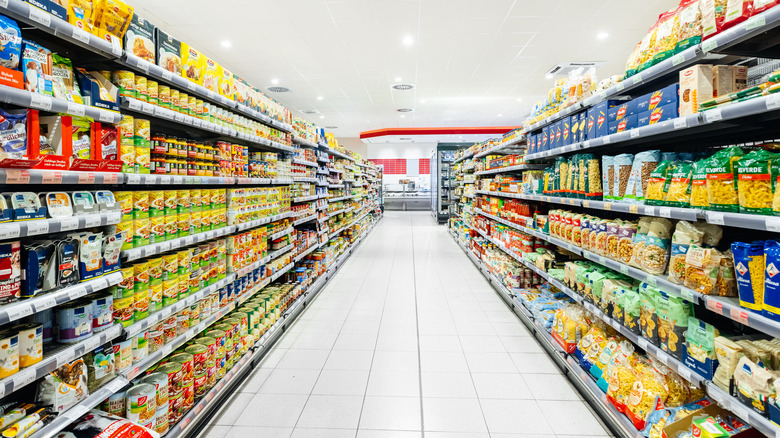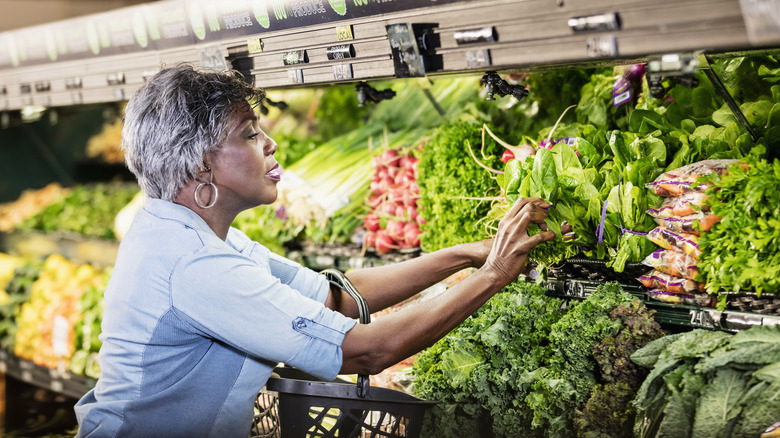Ever Wonder Why Grocery Stores Don't Have Windows?
Grocery stores are notorious for making shoppers lose track of time, and one of the biggest culprits is the lack of windows. At best, you'll see huge glass panels at the storefront, but once you step inside, there will be hardly a window to peep out into the world outside.
There are several reasons for this, and one of them is to keep sunlight away. Sunlight can cause perishables to spoil and even damage the packaging of goods, causing them to peel, discolor, or fade. This, in turn, can deteriorate the quality of the foods and drinks inside. Plus, sunlight can quickly make temperatures inside the store rise, which means supermarkets have to spend more on air conditioning to keep things cool. Moreover, sunlight — or bright light in general — can blind barcode scanners, making checkouts more time-consuming.
What's more, windows take up a lot of space — a precious commodity for supermarkets. Every window is lost room that could be used to display more items. Add to that the fact that windows themselves are costly to install, and you can start to see why they are futile investments for grocery stores. But these aren't the only reasons why supermarkets lack windows; there is a deeper, more psychological explanation for it as well.
It's all shopping psychology
Supermarkets essentially want shoppers to spend as much money inside their doors as possible, and time plays a very important role in this. A 2013 study conducted by Bangor University analyzed the brain function of supermarket shoppers to see how their behavior changed over time. It found that shoppers began to make more emotional — rather than cognitive — decisions once they had been inside a store for 23 minutes. By the 40-minute mark, their brain function deteriorated so much that logical financial decisions practically went out the window. This is why grocery stores aim to maximize the amount of time shoppers spend inside: it influences purchasing decisions and drives up revenue.
By removing windows, supermarkets create a bubble that cuts shoppers off from the outside world. It becomes harder to have a sense of time or even notice changes in the weather. If you could see that it was getting dark outside or that the weather had changed for the worse, you would be more likely to rush through your shopping. This is the same reason why grocery stores almost never have clocks either. It's harder to track time, and with every minute that passes by, you're more likely to make dubious shopping decisions.
Grocery stores use several tricks to influence shoppers
Grocery stores pay a lot of attention to details that can influence a shopper's psyche, and the lack of windows is only one of them. Thought is put into the layout of the store, which is then rearranged to play tricks on your wallet, and each item is placed on shelves with care. For example, produce, flower, and bakery sections are almost always the first things that patrons see upon entering a store. The rich aroma coupled with vibrant colors and textures in these sections is meant to make the space seem welcoming and instill an instant sense of cheer.
Staples such as dairy are placed at the very back of the store so that shoppers have to walk through several other aisles first, increasing the likelihood of them adding more things to their carts along the way — this is also why grocery aisles are so long. High-ticket items are generally placed at eye level so that they are easier to spot, whereas cheaper groceries are kept higher up where they are less likely to be noticed.
Even the music playing in the background serves a purpose. Slow music makes shoppers walk through the store at a more leisurely pace, which means they spend more time and consequently more money. From the lack of windows to the layout to the tunes playing in the background — everything in grocery stores is designed to influence shoppers in a certain way.



